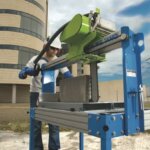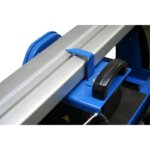Contents
Tile and brick saw vs Masonry saw
Masonry table saws and tile table saws are two of the most popular pieces of equipment from SIMA. These might look alike but they are different tools that accomplish different job functions. We will discuss shortly about some overlaps in the jobs that these can complete, but the main thing is to understand the differences between masonry saws and tile/brick saws so you can choose the tool that suits your workshop or company better.
Let’s compare: Masonry saw or tile saw?
Stone, granite, ceramic, concrete, marble amongst others abrasive materials can be cut with SIMA’s electric table masonry saws and tile saws. Thanks to their high capacity water tanks and pumps that allows the wet cutting, you and your team will be protected from harmful silica dust exposure, and it will prevent your blades from getting overheated or warped. The highest quality corrosion resistant materials are used to manufacture both types of saws. For cutting a particular material you will need a specific diamond blade on both masonry saws and tile saws.
When can you use either saw?
You can use either type of saw indistinctly if your project does not require special cutting techniques or exceed any of the parameters of your saw. For example, both a masonry saw, and a tile saw could perfectly produce a straight cut of 30mm on thick natural stone pavers as well as on ceramic or porcelain tiles. A masonry saw with a mitring option can be used for a 45 degree cut or for mitring these materials.
When Should You Use One or the Other?
The basic design and the cutting parameters are the main differences between a masonry saw and a tile saw. Firstly, masonry saws have a higher maximum cutting depth and tile saws are designed for more detailed cutting techniques. Secondly, masonry saws are provided with a sliding table that allows the stone to move during cutting, whereas the table of tile saws is stationary, which means that it’s the saw that moves during cutting. One type of saw is usually better suited for some projects than the other. A masonry saw works better with larger pieces, thicker materials with deeper, more straightforward cuts. For example, performing straight cuts on a piece of 50mm of thick granite and cutting through cast concrete of 90mm thick would require a masonry saw. By contrast, the stationary table design and the built-in gradual angle rulers of a tile saw offers greater precision for a more detailed cut, while irregular angled cuts on ceramic tiles are better suited to a masonry saw. If your project requires window cutting or drilling, you must use a tile saw. All tile saws offer the option to perform mitring cuts, however this is not available on all masonry saws.






